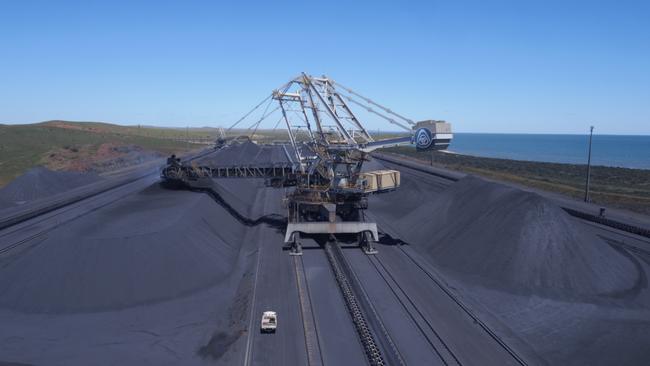CITIC’s giant Sino Iron mine books $1.33bn profit amid magnetite revival
Interest in developing Australian magnetite iron ore deposits is growing, with Sino Iron’s latest $1.33bn profit highlighting the potential of the sector.

CITIC’s giant Sino Iron magnetite mine in the Pilbara is at last repaying the faith of its owners, more than doubling its profit to $US948m ($1.33bn) last year, on the back of strong iron ore prices and ongoing cost-cutting at the energy intensive project.
The result came as Sino Iron nudges towards its 24 million tonnes a year nameplate capacity, with output hitting a record 21 million tonnes of magnetite concentrate through the year according to annual results filed to the Hong Kong exchange by CITIC.
Even though the profit came on the back of the strongest iron ore prices in a decade the result, up 121 per cent from the mine’s $US429.6m net profit in 2020, underscores the potential for the long-term investment case for the development of magnetite operations in Western Australia.
While the accounts filed with the Australian Securities and Investments Commission by CITIC last week do not give a detailed breakdown of the mine’s operations, the company said it received about $US3.28bn from the sale of iron ore concentrate through the year – implying an average price of about $US156 a tonne, up from around $US111 a tonne in 2020.
Total production and sales costs of $2.09bn for the year, implying an average cost of production of about $US99 a tonne. That is up from about $US81 a tonne in 2021, although the figure likely includes royalties paid to the state government and landlord Clive Palmer, which both rise along with the received price.
But despite the turnaround in Sino Iron’s performance, the mine is still dealing with the legacy of the missteps made during construction of the mine and processing plant.
The original budget for the processing plant was about $US3.4bn, with total project costs – including acquiring the rights to mine the tenements from Mr Palmer’s Mineralogy – estimated at about $US6bn.
But the final figure is believed to be more than $US12bn ($16bn), and Sino Iron still has more than $US5.95bn in borrowings on its books, including $US3.99bn from its parent companies.
While the profitable performance meant CITIC did not book any further impairments against the giant project, it has so far written off $US4.86bn in the value of plant and equipment and $US2.06bn in intangible assets.
And CITIC is still locked in a sprawling legal battle with landlord Clive Palmer and Mineralogy over an array of issues, with the most pressing being Mineralogy’s refusal to approve the construction of new tailings dams required to allow the mine to continue operating into the future.
CITIC described the situation as “urgent” in its annual report to shareholders.
“There is an increasing risk that Sino Iron may be forced into production curtailment or suspension if the necessary approvals and tenure cannot be secured, due to factors including the inability to access ore and insufficient space for waste and tailings storage,” the company said.
“These matters require the urgent co-operation of all affected parties.”
But despite the legacy issues, the plant’s stellar year offers fresh hope to WA’s emerging magnetite iron ore industry, amid growing interest by other major players in developing similar projects.
Sino Iron ships a concentrate grading better than 65 per cent iron that is low in impurities, an attractive proposition for steel mills looking for high quality iron ore.
Despite further blowouts at its Iron Bridge magnetite project disclosed its March quarter production report, Fortescue hopes to begin exporting a magnetite concentrate from the Pilbara by the middle of 2023.
Fortescue has also reached a deal with China’s Sinosteel to study the development of Sinosteel’s Midwest magnetite project, an agreement that could reignite the development of the long-dormant Oakajee port rail and port development.
And this year Gina Rinehart’s Hancock Prospecting and Atlas Iron have joined the magnetite fray, with Atlas saying in March it was dusting off boom-era plans to study the company’s 2 billion tonne Ridley deposit.
Atlas last month was appointed as the study manager of the Mt Bevan magnetite project, 250km north of Kalgoorlie, in a joint venture between Hancock and juniors Legacy Iron and Hawthorn Resources.
Chris Ellison’s Mineral Resources has also floated the prospect of building a magnetite plant to extend the life of the company’s Yilgarn operations, Macarthur Resources recently released a feasibility study for its Lake Giles magnetite project north of Kalgoorlie.
Grange Resources late March released a pre-feasibility study into its long-stalled Southdown project in the south of WA.


To join the conversation, please log in. Don't have an account? Register
Join the conversation, you are commenting as Logout